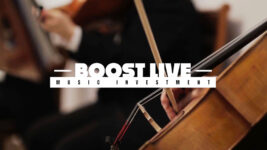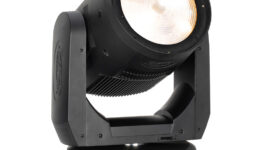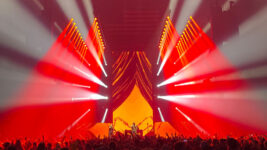LIVE
17 Feb 2025
Crowded House Gravity Stairs Tour
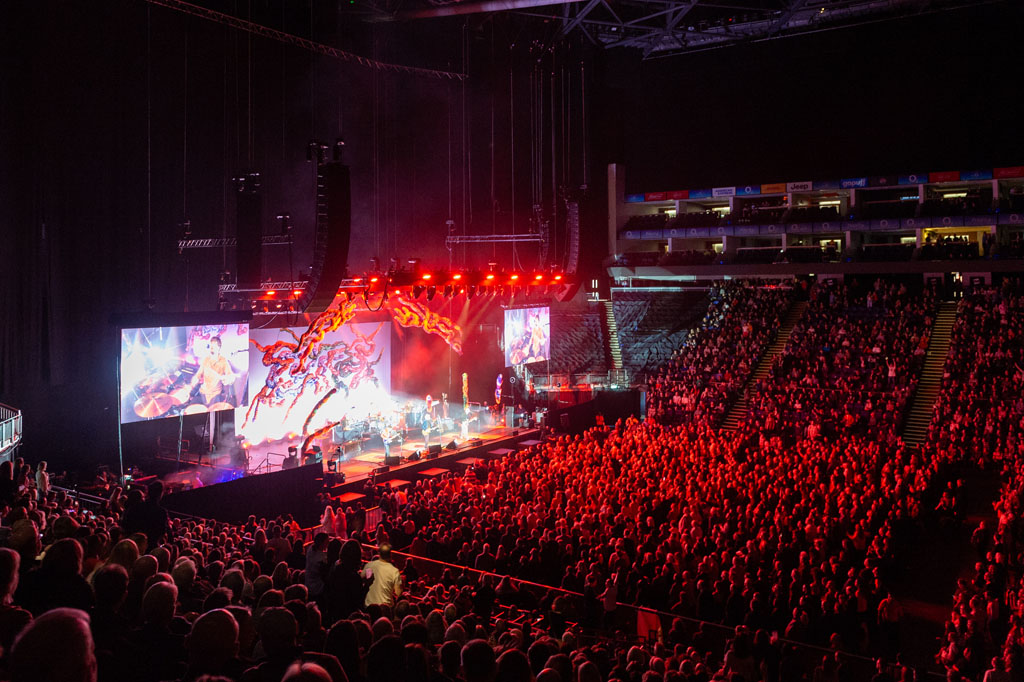
Subscribe to CX E-News
Legenday NZ-via-Melbourne band Crowded House spent a fair chunk of 2024 touring the world in support of their Gravity Stairs album. The tour finished in Australia and New Zealand with Phaseshift Productions supplying gear and crew for the Australian East Coast shows.
Lighting designer Matt Arthur requested a predominantly Martin and Ayrton rig with grandMA for control, and Phaseshift was happy to accommodate him. He also wanted three remote followspot systems, so Phaseshift presented him with the Macula system, the ground-breaking application for when a remote-controlled followspot system is required.
Matt admits that he had never heard of the Macula Followspot System before arriving in Australia. He was delighted to discover that it was very easy for him to get his head around, and it all worked the first time.
“The screens on the controllers looked good, and all I had to do was patch the fixtures in the console,” he added. “It performed flawlessly! There were no issues from my end. It seemed very simple and reliable for the operators and the lighting crew (Alex Saad and Seb Brown) charged with making it work.”
“Like all automated followspot systems, it’s such a game changer to have complete control over the follow spots without talking the operator through every cue. It allows me to concentrate on hitting the lighting cues at the right time and fully control levels and fade in/ out times. It is also great to have another option for automated followspot control.”
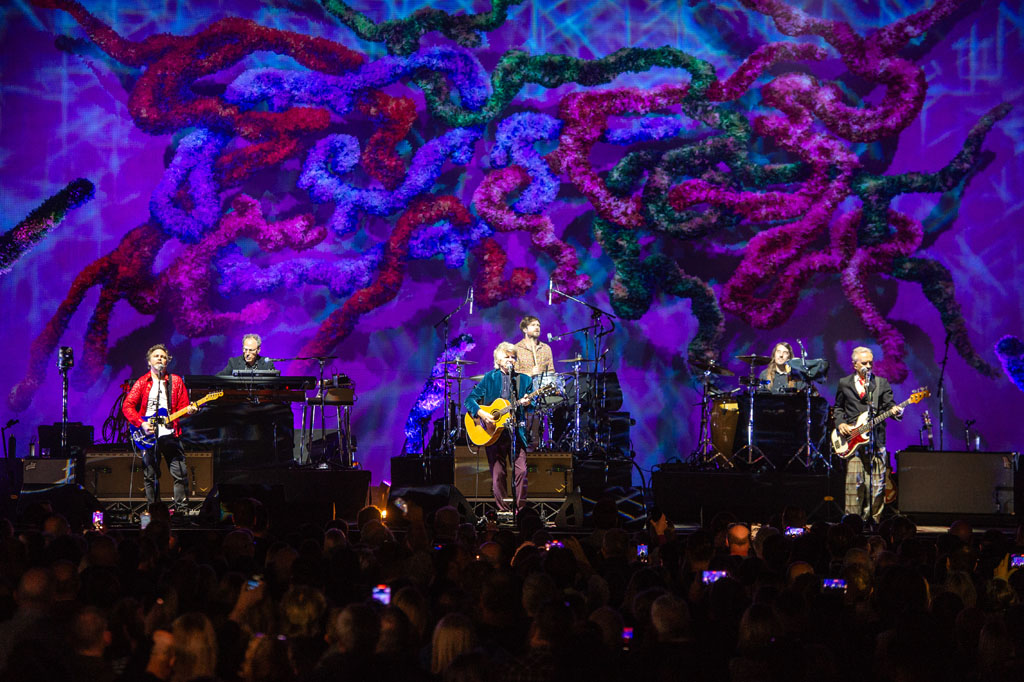
From his position as the LD, Matt says that the main thing was that the system worked straight out of the box and was reliable on each load-in. It just worked!
“In the past, I have had some day-to-day issues with other systems that took up time and didn’t make sense, so having a solid system, especially when it was the main performer’s key light for the cameras, was a big win.”
After being recommended for the position of lighting designer by Noreen O’Riordan from Entec Live in the UK, Matt spoke with Rick Purcell, the TM, about the visual direction of the show.
“The overall brief from Rick and the band was to create a theatrical, scene-based show,” explained Matt. “That kind of thing was right up my street, and knowing the music intimately made it easy to achieve. Obviously, there were times when the dynamics of the music called for flash-and-dash moments, but for the most part, especially with the amazing backdrop and scenic pieces to light, it was about creating varying colourful worlds for the songs to live within.”
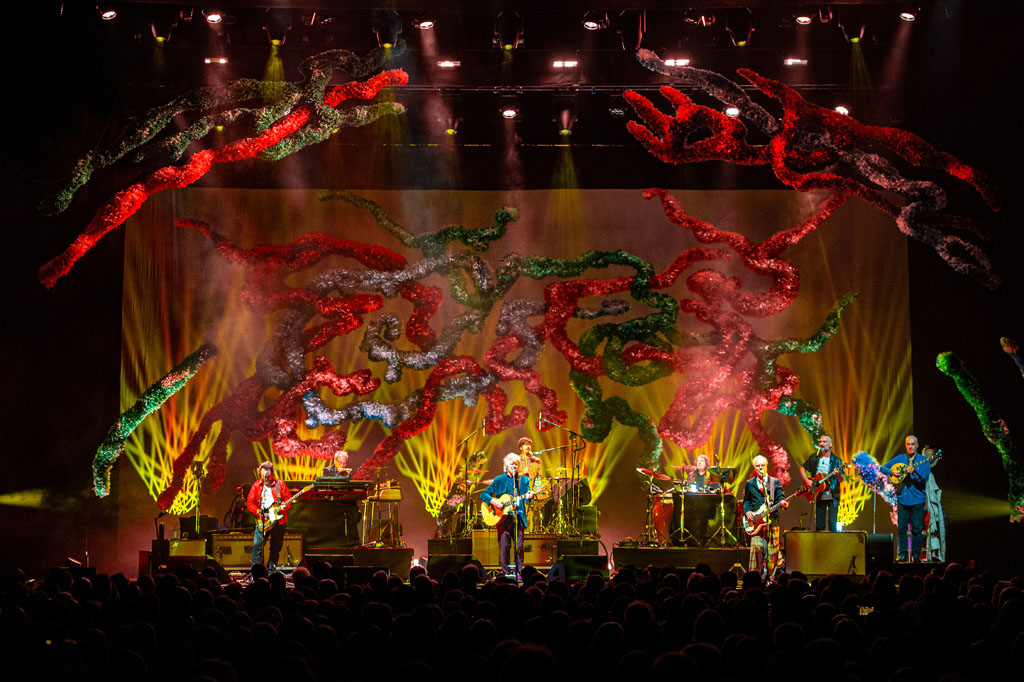
The scenic elements came in a few stages to get to the show presented in Australia and NZ. When Matt was first approached about the tour, the backdrop was already in the mix and being created by Noel Crombie out of Melbourne. Noel has been involved with all of the scenic elements for Crowded House over the years, so the overall look and aesthetic of the tour were already laid out. This made Matt’s job easier, as there was a unique focal point to build upon for future legs.
“Initially, it was me as LD and the sole LX Crew, so the system had to be manageable and fit into a small truck space,” he said. “I opted for a low, 12m floor-based pre-rig truss with eight Martin MAC PXL and some strobes. These lit the drape and also shot forward through the band. That row of lights has remained unchanged throughout as it worked well.
“I also started two Ayrton Eurus on each side of the drape, chosen for their wide zoom and nice UV, all controlled by our touring a grandMA3 light and compact control package. As we progressed into UK arenas, Neil Finn, Noel, and I discussed the idea of the band playing within the organism surrounding them. We added some mid-hung drapes to create a false proscenium, a grey cyc hung 1m upstage of the main drape, and six floor-standing pieces, or “feather dusters,” as they became known. Lighting-wise, we have the full spec you see here in Oz.”
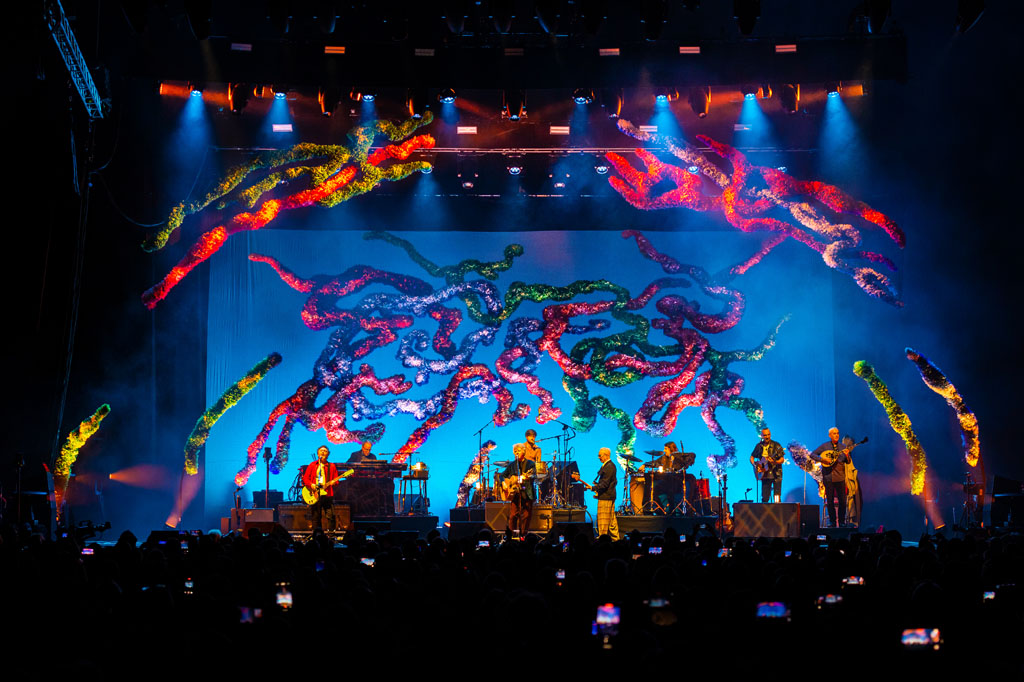
Once the scenic layers were established, certain lighting design elements were added to highlight them. The mid drapes got MAC Aura XBs/MAC Ones, the feather dusters got MAC Aura XBs and the band and cyc got some Ayrton Eurus/Perseo. Of course, they could all do other things, but their main “job” in the design was those elements.
“Adding the cyc made a huge difference,” commented Matt. “The added ability for gobo projections helped to make it feel like the band were underwater for “Fall At Your Feet”, with that chorus guitar sound, or for “Distant Sun”, have them standing in front of a blazing sun. Side-lighting the band with the spots also helped maintain a focus on them, and matching gobos all around added to the ability to tie it all together.
“I had such a lovely time lighting up the band with their fabulous songs, but having the scenery to create this unique, colourful world was a real treat. The way I could throw a blue at it, and because of all the different tones in the fabric, it took on varying hues, was impressive. So much of the placement and focus of the fixtures allowed me to catch the light and shade of its bulk. Much experimentation was done, and, at times, the set felt like it was alive. I learnt a lot! Many people approached me after the show and asked, “How does that backdrop work? Is it a projection?” And the obligatory ”It sounded great!”
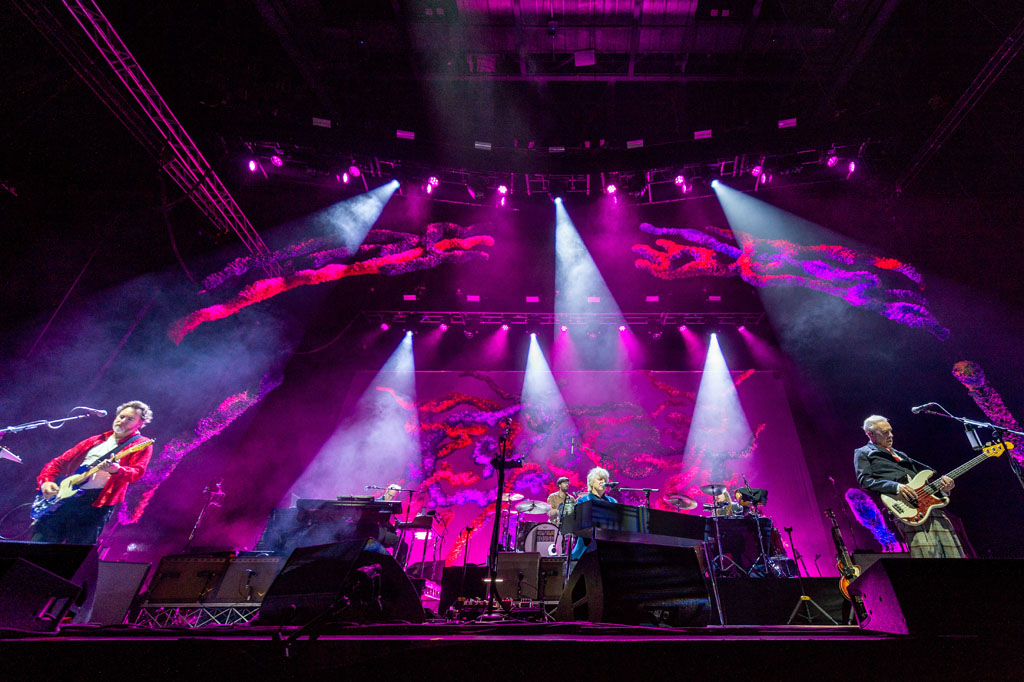
Ayrton Perseo Profile S
Matt utilised 37 Ayrton Perseo in Australia, saying they were an easy substitute for the Eurus as they have almost the same feature set. There were 25 in the air and 12 on the floor. The flown Perseo were placed on the three overhead trusses between the wash lights. The front and rear trusses were straight, whereas the mid truss had a ”U-shape” appearance due to a 1.5m straight piece in the centre with 6m lengths at 10 degrees running off each side.
This shape helped to give a forced perspective to the mid-hung drape pieces and followed the front line of the angled band risers.
The flown design was a generic spot/wash/ spot/wash configuration. Because Matt had come through numerous festivals and house rigs from which the majority of the overhead programming was generated, and with the small window of programming time into the arena run, he didn’t have time to start again, so he just tweaked what he had which worked well … adding more specificity to the cues once he had a rig for more than one night!
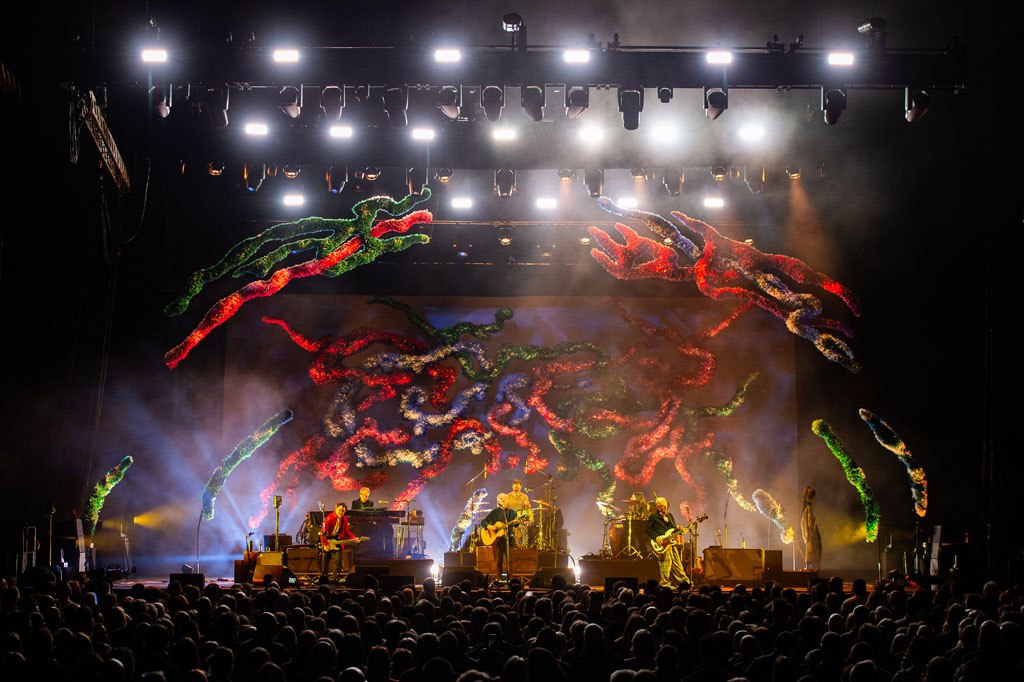
There were 12 Perseo on the front truss; six were general workhorse spots for cyc/backdrop gobo projection looks and general beams and gobos. Three were specific keylights locked off on the three band members on the risers, and the remaining three were linked to the Macula system for followspot duties on the guys downstage.
The mid-truss had seven fixtures, and the rear truss had six. This layout ensured Matt had at least two backlights behind each band member to achieve varying angles when picking out each performer. These also supplied gobo projections on the drape and general backlight and aerial effects.
The floor layout consisted of three Perseo per side to cross-light the band with gobos and effects and side-light the backdrop. A further six units upstage between the backdrop, and cyc added a lot of depth and helped make the backdrop appear to float at times.
“With the Ayrton Perseo Profile S, I like the flat field of light with their LED engine,” said Matt. “I like that they have shutters. They can produce some nice colours, and the white out of the box is good; they have a nice wide zoom. The gobos are the same in most of the Ayrton range. It’s a good solid fixture that worked well daily with minimal resets and/or swap-outs.”
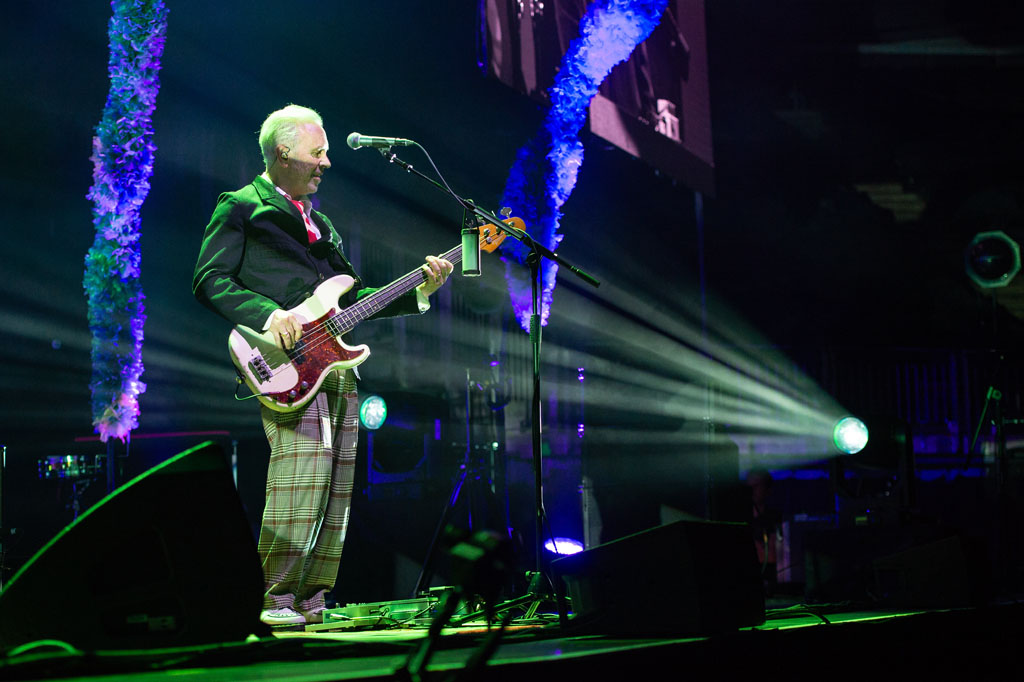
Martin MAC Auras/MAC Ones
Matt has been using the MAC Aura XB for years and is always happy to use them, adding that he loves the size and the colours, primarily white straight out of the box. The zoom is excellent and pretty bright, which helps them compete when paired up with most modern spots. And because they are an older fixture, you can tend to get more of them for your money without compromising on output and features. The XBs on this leg had a straightforward job of lighting the six floor-mounted set pieces. Quite literally, one position to illuminate and highlight these pieces was a simple task, but they did the job perfectly!
“In the UK, I had another eight MAC Aura XBs outrigged off the mid-truss to illuminate the mid-proscenium drapes and the backdrop,” Matt said. “On the Oz run, these were replaced by 31 x MAC Ones, the second time using MAC Ones, and they were okay.”
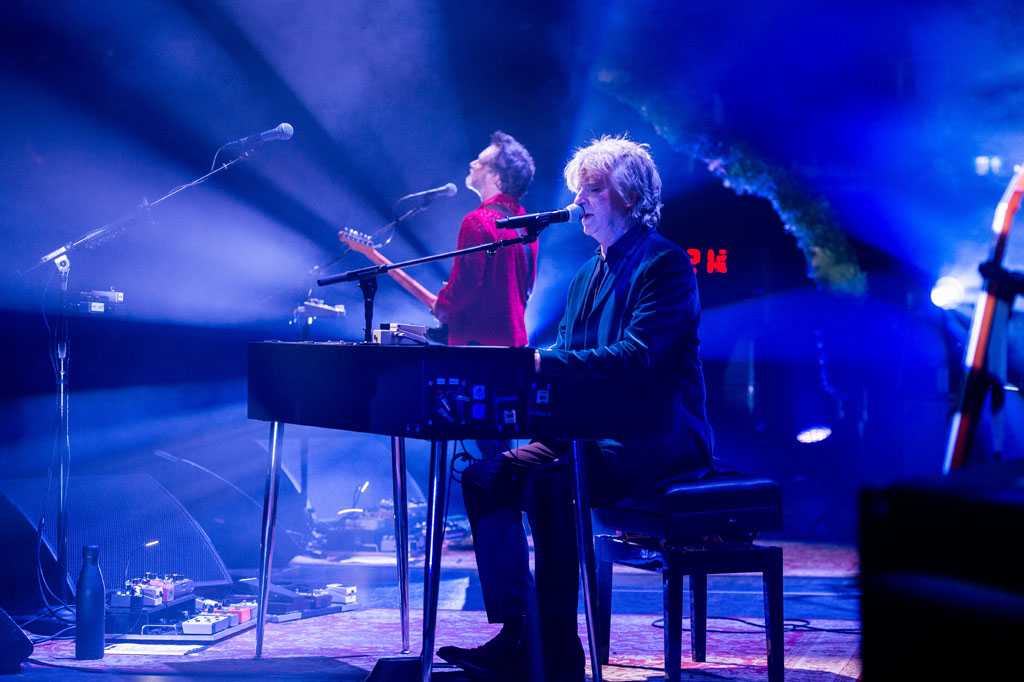
“I like their size and weight and can see how they would be great in larger numbers, closer together and not as high off the ground. They cloned easily, coming from other Martin products, so colours and beams were pretty spot on … the obligatory tweaks here and there were required.”
Eight MAC Ones were placed on the mid-truss, with seven on the upstage truss, all in between the spots for the primary truss washes. They mainly provided backlight on the performers with occasional beam and movement effects to keep it interesting. As well as the eight previously mentioned for the mid-drape pieces, eight MAC Ones were evenly distributed between seven JDC1s on the floor upstage, where their main job was to uplight the backdrop and shoot light forward on occasion.
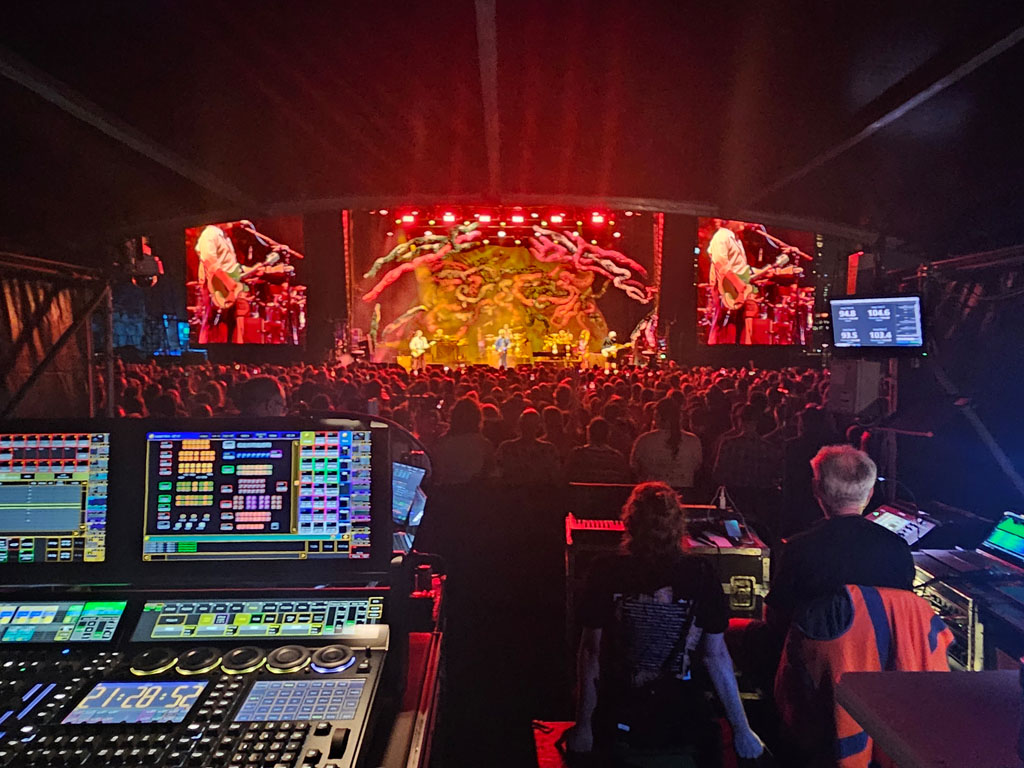
MA Control
The show was on grandMA3 hardware, but it was still running grandMA2 software. Matt likes the grandMA3 consoles with their nice buttons, smooth faders and customization abilities, but he hasn’t yet jumped to grandMA3 software.
“I did some training in grandMA3 mode through grandMA University in lockdown, but having only been an grandMA convert for about three years, I wanted to feel comfortable on grandMA2 before taking on grandMA3, as I know it is a big transition,” he explained. “I programmed the base show with Chris Yeomans punching the buttons at my house on WYSIWYG before heading out on the first run, and since then, I have tweaked and added a lot on the road.”
Matt was going into several festival scenarios where he had a different flown rig most days, so he kept the presets relatively simple. There is no timecode, as you can expect from this type of band and all cues are triggered live and manually, which is his preference. Each song has its own macro, which triggers a “Talk” cue, as there is always banter between the songs before they get into the main part. The songs aren’t that intricate and follow a standard intro/ verse/chorus/bridge structure, so they’re pretty straightforward.
Photos by Joseph Okpako
Subscribe
Published monthly since 1991, our famous AV industry magazine is free for download or pay for print. Subscribers also receive CX News, our free weekly email with the latest industry news and jobs.

